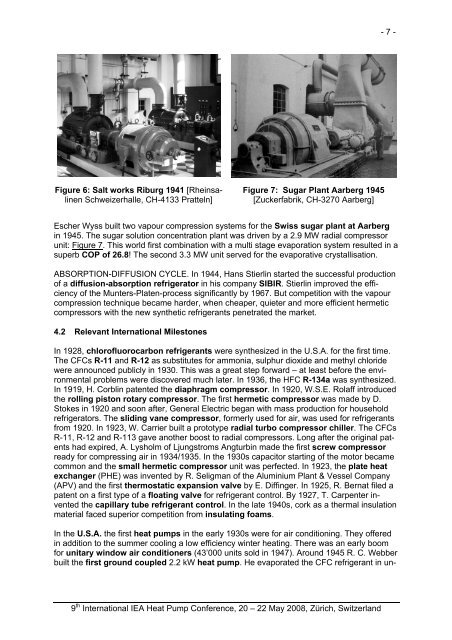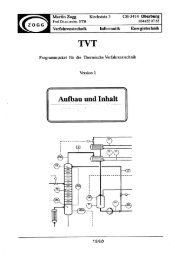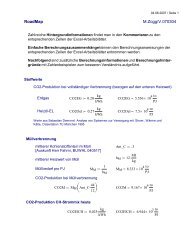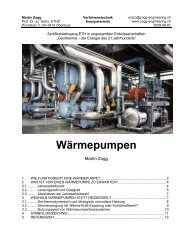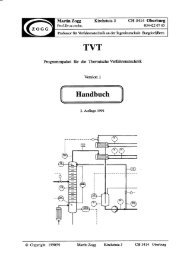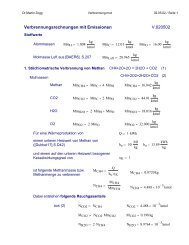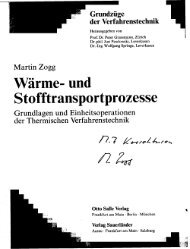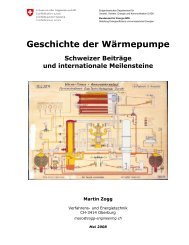TITLE, PLEASE USE 14-pt ARIAL FONT, BOLD ... - of Martin Zogg
TITLE, PLEASE USE 14-pt ARIAL FONT, BOLD ... - of Martin Zogg
TITLE, PLEASE USE 14-pt ARIAL FONT, BOLD ... - of Martin Zogg
You also want an ePaper? Increase the reach of your titles
YUMPU automatically turns print PDFs into web optimized ePapers that Google loves.
Figure 6: Salt works Riburg 1941 [Rheinsalinen<br />
Schweizerhalle, CH-4133 Pratteln]<br />
Figure 7: Sugar Plant Aarberg 1945<br />
[Zuckerfabrik, CH-3270 Aarberg]<br />
- 7 -<br />
Escher Wyss built two vapour compression systems for the Swiss sugar plant at Aarberg<br />
in 1945. The sugar solution concentration plant was driven by a 2.9 MW radial compressor<br />
unit: Figure 7. This world first combination with a multi stage evaporation system resulted in a<br />
superb COP <strong>of</strong> 26.8! The second 3.3 MW unit served for the evaporative crystallisation.<br />
ABSORPTION-DIFFUSION CYCLE. In 1944, Hans Stierlin started the successful production<br />
<strong>of</strong> a diffusion-absor<strong>pt</strong>ion refrigerator in his company SIBIR. Stierlin improved the efficiency<br />
<strong>of</strong> the Munters-Platen-process significantly by 1967. But competition with the vapour<br />
compression technique became harder, when cheaper, quieter and more efficient hermetic<br />
compressors with the new synthetic refrigerants penetrated the market.<br />
4.2 Relevant International Milestones<br />
In 1928, chlor<strong>of</strong>luorocarbon refrigerants were synthesized in the U.S.A. for the first time.<br />
The CFCs R-11 and R-12 as substitutes for ammonia, sulphur dioxide and methyl chloride<br />
were announced publicly in 1930. This was a great step forward – at least before the environmental<br />
problems were discovered much later. In 1936, the HFC R-134a was synthesized.<br />
In 1919, H. Corblin patented the diaphragm compressor. In 1920, W.S.E. Rolaff introduced<br />
the rolling piston rotary compressor. The first hermetic compressor was made by D.<br />
Stokes in 1920 and soon after, General Electric began with mass production for household<br />
refrigerators. The sliding vane compressor, formerly used for air, was used for refrigerants<br />
from 1920. In 1923, W. Carrier built a prototype radial turbo compressor chiller. The CFCs<br />
R-11, R-12 and R-113 gave another boost to radial compressors. Long after the original patents<br />
had expired, A. Lysholm <strong>of</strong> Ljungstroms Angturbin made the first screw compressor<br />
ready for compressing air in 1934/1935. In the 1930s capacitor starting <strong>of</strong> the motor became<br />
common and the small hermetic compressor unit was perfected. In 1923, the plate heat<br />
exchanger (PHE) was invented by R. Seligman <strong>of</strong> the Aluminium Plant & Vessel Company<br />
(APV) and the first thermostatic expansion valve by E. Diffinger. In 1925, R. Bernat filed a<br />
patent on a first type <strong>of</strong> a floating valve for refrigerant control. By 1927, T. Carpenter invented<br />
the capillary tube refrigerant control. In the late 1940s, cork as a thermal insulation<br />
material faced superior competition from insulating foams.<br />
In the U.S.A. the first heat pumps in the early 1930s were for air conditioning. They <strong>of</strong>fered<br />
in addition to the summer cooling a low efficiency winter heating. There was an early boom<br />
for unitary window air conditioners (43’000 units sold in 1947). Around 1945 R. C. Webber<br />
built the first ground coupled 2.2 kW heat pump. He evaporated the CFC refrigerant in un-<br />
9 th International IEA Heat Pump Conference, 20 – 22 May 2008, Zürich, Switzerland


